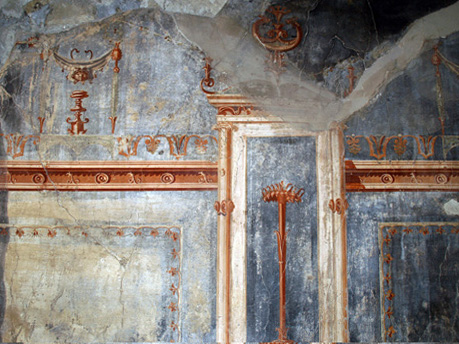 1>
1>Vitruvius, whose writing was contemporary with the late Second and early Third Style, was not concerned with issues of copying or imitating. His critique, as outlined in the previous quotation, focused on compositions that did not conform to the known world as he perceived it. As both an architect and civil and military engineer, he interpreted the known world in terms of structural logic and therefore objects and their simulacra were expected to conform to the physical laws that governed structural logic. He seems to have included myth, religion and their visual manifestations as part of the ‘known world’. Providing their representations conformed to physical principles, he levelled no criticism against them. Imagined imagery such as winged deities, or the supernatural activities of gods, posed no visual or ethical problems for him, so long as they appeared to function within physical parameters that appeared logical.
Diversity as a Style? (Intricate or Fourth Style)
When one looks at the corpus of wall-paintings generally classified as the Fourth Style, it is extremely difficult to see how they can be defined as a 'style'. The wall-paintings grouped under this classification range from almost entirely monochrome walls with the merest of architectonic references to highly elaborate architectural compositions echoing Second Style facades (fig.1-2). Mau tried to present this style as a return to architectural order, in which the ornate fantasies of the Third style are replaced by the kind of structural coherence and physical conformity favoured by Vitruvius. He also saw it as having no developmental relationship with the Third and hence described it as a foreign import.
“The fourth style cannot have been derived from the third. It is organically related with the second, out of which it was developed by laying stress on precisely that element, the architectural, the suppression of which gave rise to the third style of decoration. The most reasonable explanation of the relations of the four styles, briefly stated, is this: — The Incrustation Style, a direct offshoot of Hellenistic art, was prevalent in eastern cities, where it was naturally followed by the Architectural Style ; this may have been developed at one centre or, in different phases, at different centres contemporaneously. At some prominent centre, probably Alexandria, the Architectural Style passed over into the Ornate Style, which was introduced into Italy in the reign of Augustus and remained in vogue till the middle of the first century A.D. Meanwhile, at some other centre of culture, possibly Antioch, the Architectural Style, by an equally natural course of development, had passed over into the Intricate Style (Fourth), which was first brought to Pompeii about 50 A.D. and remained in fashion till the destruction of the city.” (Mau 1899: 459-460)
The so called Fourth or Intricate Style is so obviously a blend of Second and Third Styles that it is, at times, virtually indistinguishable from both. This makes Mau's theory that it was linked to the Second style, developed independently elsewhere and was then reimported into Italy even more difficult to comprehend.
|